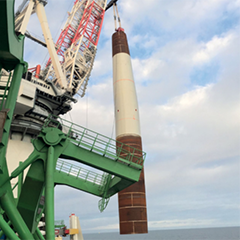Words: Steven Foong, Global Maritime
This article will look at the marine operations standards and guidelines that are emerging; areas that need to be considered in putting in place such standards; and how it is also incumbent on the marine providers themselves to put the necessary mechanisms in place internally.
There’s no doubt that offshore wind is on the increase in Europe, Asia and the United States.
Bloomberg New Energy Finance, an energy research organization, predicts that the world’s offshore wind-generation capacity will quadruple by 2025. The size of wind turbines is also increasing at such a rate that turbines with a capacity of up to 15MW are likely to be installed in the near future, according to the Chief Executive of Renewable UK, the UK trade association.
The European Wind Energy Association also estimates that between 20 GW and 40 GW of offshore wind energy capacity will be operating in the European Union by 2020.
Yet, just as the industry is continuing to grow, so do the necessary marine standards need to improve to ensure safe and effective operations.
Current standards & guidelines
So what current marine operations standards and guidelines are being used?
While such standards and guidelines in offshore wind were perhaps slow to take off, with the industry often implementing its existing HSEQ standards to the offshore wind environment, the last few years have seen the emergence of a variety of best practice guidelines. Some are focused predominantly on upstream oil & gas operations but which can be transferred to offshore wind and others focus specifically on offshore wind.
Lloyd’s Market Association and the Joint Rig Committee, for example, have published a number of documents designed to assist insurers, operators and third party contractors better assess specific risks associated with offshore facilities. This includes guidance on the scope of activities for marine warranty surveyors required to ensure the safe movement of rigs and the safe conduct of upstream construction project operations such as load-out, transportation and installation.
The International Organisation for Standardisation 29400:2015 is more specific to offshore wind, covering information related to port and marine operations necessary for the installation and maintenance of offshore wind farms. It covers, among others, foundations made from steel and concrete gravity base structures; piled steel foundation structures; subsea templates and similar structures applied for pre-piling of foundations; steel towers; mobile offshore units; jack-up vessel and self-elevating offshore unit topsides; and array cables within the wind farms.
Other organisations that are playing an important role in establishing marine guidelines include the International Marine Contractors Association who have been developing optimal designs and configurations to ensure the safe access to wind turbine foundations from crew transfer vessels; and classification society DNV GL who – as well as providing guidance on offshore wind structures – are also providing input to marine operations.


























